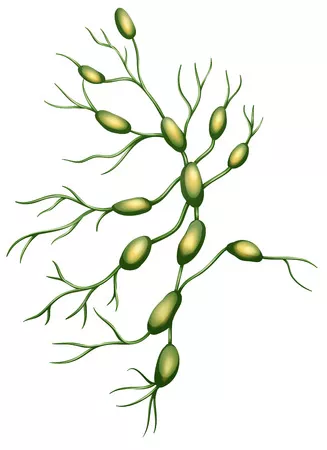Pheochromocytoma
The adrenal glands are triangularly shaped endocrine glands positioned on top of the kidneys. These glands consist of a medulla that is surrounded by a cortex. The medulla (inner) is the one responsible for the production of the hormones norepinephrine and epinephrine. The cortex (outer), on the other hand, produces the glucocorticoids hormones such as cortisol, androgens (testosterone) and mineralocorticoid hormones such as aldosterone (for fluid and electrolyte balance).
These suprarenal glands are considered to be the anti-stress glands of the system. The hormones they produce allow the body to deal with stress. These tiny glands would determine the energy of a person’s response to the changes in the external and internal environment.
Adrenal hormones would influence the body’s every important physiological processes. They affect the body’s consumption of fats and carbohydrates, the conversion of protein and fats into usable energy, the allocation of stored fats, regulation of normal blood sugar and the proper functioning of the gastrointestinal and cardiovascular systems. The anti-oxidants and anti-inflammatory activity of the hormones produced by this tiny gland protects the individual from allergic and other negative reactions to drugs, foods, alcohol and other environmental allergens.
After menopause, the suprarenal glands slowly become the main source of sex hormones for women. These hormones have effects on the sex drive and the inclination for weight gain; and even to the tendency to acquire certain diseases. They also influence the person’s capacity to react to chronic illnesses and the more chronic it is, the more critical the response of these glands would be.
What is Pheochromocytoma
Adrenal gland tumor, specifically at the medulla is called pheochromocytoma. This condition would result to excessive secretion of catecholamines (norepinephrine and epinephrine), the hormones that influence metabolism, blood pressure and heart rate. Too much catecholamine secretion could trigger the onset of life-threatening cardiac arrhythmias and hypertension.
About eight hundred new cases are diagnosed every year in the United States. Only about 10 to 15 percent of pheochromocytomas are cancerous with the possibility to metastasize. This adrenal gland problem occurs at any age but is most common at ages 30 to 40 years. Some individuals are asymptomatic and a retrospective analysis made by Mayo Clinic showed that in fifty percent of the cases, the diagnosis was done during autopsy.
Pheochromocytoma Symptoms
Symptoms of pheochromocytoma are basically the result of the excessive secretion of catecholamines in the system and therefore would include:
- Paroxysmal hypertension
- Severe headache
- Tachycardia
- Nervousness or anxiety
- Diaphoresis
- Hand tremors or tingling sensation at the tip of the fingers
- Epigastric pain
- Flank pain
- Nausea with no vomiting
- Loss of weight
- Intolerance to heat
- Irritability
- Pallor
- Insomnia
- Hyperglycemia due to the lipolysis stimulation, gluconeogenesis and glycogenolysis
- Constipation
- Café au lait spots – patches of pale to dark brown skin pigmentation (1 to 10 mm) more prominent at the axilla and groin.
- Erythrocytosis
These symptoms of pheochromocytoma may present at irregular intervals and would frequently last for fifteen to twenty minutes. As the tumor gets bigger, the attacks may increase in length, frequency and severity.
Pheochromocytoma Diagnosis
Most individuals are asymptomatic but when the physician would find some symptoms of pheochromocytoma such as prominent elevation of vital signs during physical exam, then several diagnostic tests are to be done.
Pheochromocytoma Tests
Typical tests on hand to detect pheochromocytoma would include:
- The 24-Hour Urine metanephrines and catecholamines test would quantify the various hormonal compounds secreted by the adrenal glands. Increasing intermittent excretion would indicate the presence of the disease.
- Serum catecholamines
- I-MIBG and CT scans would help determine the location of the tumor.
- MRI (preferred imaging diagnostic test)
- PET Scan
- Adrenal Biopsy
Serum metanephrine tests have 96% sensitivity but 85% specificity for pheochromocytoma detection while the 24-hour urine collection has 87.5% sensitivity and 99.7% specificity. Major stress and some drugs such as antidepressants would cause false elevation of metanephrines in the urine.
Pheochromocytoma Treatment
The treatment of choice for this condition is surgical resection of tumor. However, surgery is usually delayed until the catecholamine levels are controlled with drugs. Elevated levels of these hormones during the surgical procedure can be very dangerous. Phenoxybenzamine is initiated to stop the secretion of catecholamines. As soon as this is achieved, alpha-blockers are given to promote relaxation of muscles that help keep small blood vessels open by counteracting the effects of norephinephrine on these vessels thus lowering the blood pressure. Beta-blockers are also given to decrease heart rate and contractility of the heart muscles by slowing the nerve impulses travelling to the organ.
If the tumor has metastasized, then chemotherapy is started through oral or intravenous route. Other options include radiation therapy which uses high-energy X-rays to shrink tumors and kill the cancer cells or radioisotope therapy which uses I-MIBG in high doses to shrink the tumors.
Pheochromocytoma Workup
The standard workup to confirm pheochromocytoma diagnosis is measuring the following urinary catecholamines plus their metabolites for 24 hours:
- Epinephrine
- Norepinephrine
- Dopamine
- Metanephrine
- Homovanillic acid
- Vanillymandelic acid
Collection should be done while the patient is not taking any medications or recent exposure to any radiographic contrast medium. Patient should be at relaxed –physically and emotionally. Any food and medications that would affect the result of the test is avoided such as tea, coffee, cocoa, chocolate, vanilla, bananas, and citrus fruits.
Other laboratory workups include CBC (to determine presence of infection), electrolytes, BUN, creatinine and glucose levels, serum calcium levels, and urinalysis (+protein would indicate hypertension). Levels of serum intact PTH is also checked to exclude primary hyperparathyroidism.
ECG findings may show abnormalities such as tachycardia, arrhythmias and left ventricular hypertrophy. CT scans of the pancreas and kidneys are also done to rule out cysts.
Genetic testing can also be carried out if there is positive family history, multifocal and specific tumor locations or manifestation of symptoms at a young age.
Pheochromocytoma Complications
Elevated blood pressure due to pheochromocytoma exerts too much force on the arterial walls which could cause significant harm to the vital organs they supply. The longer this keeps on, the bigger the damage it would bring about. Untreated blood pressure elevation could cause the following complications:
- Stroke
- Heart failure
- Sinus tachycardia
- Peripheral vasodilation
- Acute respiratory disease
- Kidney failure
- Psychosis
- Seizures
- Impaired vision
- Focal myocarditis
- Acute hypertensive crisis
- Early death
Chronic exposure to the catecholamines would increase the risk of diabetes, congestive heart failure and heart muscle damage.
Pheochromocytoma Surgery
Once these are controlled, then surgery (adrenalectomy) is performed to remove the tumor. Depending on the location and size of the tumor, an alternative procedure – laparoscopic surgery- can be done. The surgical procedure entails the insertion of a scope in a small incision to help the doctor visualize the abdomen while another small incision is made to allow the passage of the surgical instrument into the abdominal cavity. This would result to a more rapid recovery compared to the traditional surgery.
Studies have also shown that patients who underwent laparoscopic surgery showed lesser hypertensive episodes and need for post-op analgesics. If performed by an experienced surgeon, this surgical approach is considered to be the choice for pheochromocytoma.
Pheochromocytoma Prognosis
Most patients with benign tumors surgically removed have good prognosis, some 95 percent are still alive after five years but there are cases (less than ten percent) when the tumors would reappear. The levels of the catecholamines would go back to normal following surgery. In general, patients with benign localized tumors that were surgically removed have good outcomes.
Below fifty percent of those with cancerous tumors that has metastasized to the liver, lungs or bones are alive later than 5 years. Pregnant patients with this disease condition have poor outcome (including the fetus) with a mortality rate of approximately fifty percent.
References :
http://www.umm.edu/ency/article/000340.htm
http://emedicine.medscape.com/article/124059-overview
http://www.nlm.nih.gov/medlineplus/pheochromocytoma.html
http://www.merckmanuals.com/home/sec13/ch164/ch164f.html


